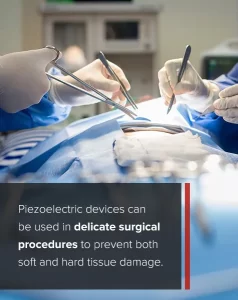Jump To: What Are Piezo Sensors | How It Works | Common Applications | Why Piezoelectricity Matters

In the late 1800s, Jacques and Pierre Curie discovered the piezoelectric effect. The pair determined that minerals like quartz generated an electric charge after being imposed upon by a mechanical force. Since this discovery, piezoelectric sensors have been implemented in various industries, including the healthcare field.
What exactly are piezo sensors and how do piezo and healthcare work together? What are the uses of piezo sensors in the healthcare industry? Piezo sensors can have a variety of beneficial uses in healthcare.
Piezo derives from the Greek word piezein, meaning “physical pressure.” Piezo sensors are devices that are activated via physical pressure. These sensors use the piezoelectric effect for measuring changes in acceleration, strain, force, movement or temperature by converting them to electrical charges.
As such, piezo is used effectively in various aspects of the healthcare industry. For example, piezo sensors can be used to reduce noise, reduce vibration or modify a response.
Shock and vibration can shorten the life of an electronic device or electromechanical system. Impacts from shock and tears can result in intermittent failure, which is often a difficult system failure to debug. Piezo sensors can reduce these vibrations or shocks and help electronic devices and systems last longer.
Piezo properties can be found in several materials that occur in nature:
Though natural materials continue to be used today, manmade materials are more common in the production of the piezoelectric effect.

When pressure is applied to a material with piezoelectric properties or a crystal, a voltage can be generated. Piezoelectric technology is developed based on the orientation of the material, the symmetry and the reaction to different kinds of mechanical stress.
A mineral like quartz or tourmaline can create electrical charges from mechanical energy. The pressure applied is proportional to the voltage that occurs, and these piezo sensors can detect both single-pressure events and repetitive-pressure events. The use of piezoelectricity became more practical when high-input impedance amplifiers were used to increase the signals produced by these minerals.
Piezo sensors are made from quartz, tourmaline, salts or gallium phosphate, though most electronic applications of piezo sensors use quartz. These sensors work operate via longitudinal, shear or transverse forces, and they’re ideal for rugged or harsh environments.
Piezoelectric crystals are similar to batteries in that they both have a negative charge on one face and a positive charge on the other. Over time, we have refined the technology and expanded the uses and options of piezoelectricity.
Sensors tell engineers where something is headed, along with the rate at which it is traveling. They’re valued highly for their responsiveness and strength, and they can be used in various forms of technology, such as key fobs, intruder alarms, smoke alarms, microwave ovens, exercise equipment and medical devices.
Applications that involve sound tend to be the most common for piezo sensors, such as microphones and amplifiers. Piezo sensors are also used in electric lighters or gas appliances, such as a water heater or gas stove, and in motors because they can create reliable and precise motion.
Piezoelectric sensors have several properties that make them valuable in the healthcare industry. What are the common applications of piezoelectricity and piezo sensors in the healthcare industry?
One use of piezoelectricity is in ultrasound equipment. Medical professionals can use piezoelectric transducers in their medical devices to monitor pregnancies and perform surgical procedures that are less invasive. Some non-invasive procedures include destroying malignant tissue and breaking up kidney stones.
Piezo sensors can aid in the detection of patients’ vital signs, such as their pulse. Many sensors can monitor pulse by being attached directly to the skin via a self-adhesive side, combined with intervening layers or even by being carried in pockets.
Piezoelectric medical tools are used to enhance medical services. One of these medical tools is stethoscopes. In stethoscopes, piezo sensors can offer increased sensitivity to make the performance of this medical tool more precise.
Piezo sensors can also be used in sleep studies. Sensors measure muscle movements in patients’ eyelids, chests and legs to detect sleep disorders. These physical signs are often tiny, and piezo sensors are well-suited to picking up these nearly imperceptible signals.
Another common use of piezo sensors is in measuring the effectiveness of anesthesia. Piezo sensors can monitor the effectiveness of anesthesia by measuring muscle responses to electrical stimulation.

Piezoelectricity is also used in dental scalars. Ceramic rings in the device create vibrations and the scalar can perform at ultrasonic frequencies. The function of piezoelectric devices in dental scaling is to treat root canals and remove biofilms that have accumulated on the surface of teeth. Calculus and plaque can threaten dental health, and the vibrations from piezoelectric devices can break these down to maintain the health of a patient’s teeth. The scalar also cleans the tooth as it passes over, making the device even more effective.
Factors that influence how a scalar is used and its effectiveness are the power setting, tip angle and lateral force. Dental professionals can risk damaging a tooth’s enamel if the power is too high, so the device needs to be used correctly and precisely to be as effective as possible.
According to the World Health Organization, about 15% of adults have at least some level of hearing loss and about 360 million people worldwide have disabling hearing loss. The cochlea plays a key role in our ability to hear a wide range of sound perception and frequency selectivity, but it’s also a delicate structure prone to degradation.
While a hearing aid can restore hearing after mild or moderate damage to the cochlea, a cochlear implant tends to be the preferred treatment for severe hearing loss.
After severe hearing loss occurs due to the destruction of the inner ear cells, patients are often treated with cochlear implants. Cochlear implants do have some downsides, such as high power consumption. On the other hand, piezo materials can create an artificial basilar membrane, which mimics mechanical frequency selectivity. Piezoelectric materials can allow the basilar membrane to perform as it should and can filter frequencies based on physical properties. Fabricated PVDF membranes can detect signals in the range of human vocalizations.
Because piezoelectric materials can convert mechanical vibrations into electricity, they may be a potential alternative to a cochlear implant or improve the technologies that provide recovery from deafness.
Another exciting application of piezo sensors is the detection of odor and disease. Quartz is a piezoelectric material, and quartz microbalances have several uses, such as chirality classification, composition analysis, gas detection and changes in liquid viscosity and density.
When the mass of the coating film surrounding the crystal increases, this is an indication that the frequency of the quartz vibration has decreased. When the mass becomes too large, approximations can become inaccurate. To address this potential problem, piezoelectric materials can be attached to biological molecules to create a technology that can detect biomolecules and bacteria.
Sensors are also able to detect glucose without the use of enzymes. This can be advantageous in the medical industry, though the lack of enzyme use usually means the detection range is lower. The quartz microbalance can also be used for the creation of bioelectronic olfactory replacements.
Another application is to measure odors or to detect hazardous odors that can cause damage to humans. One example is diacetyl, an odorant that can damage the lungs if inhaled.
The development of synthetic skin is another application for piezoelectricity. One of the goals with synthetic skin is to provide the same level of sensitivity one would have with normal skin. Synthetic skin should be able to sense touch, humidity and changes in temperature.
Piezoelectricity comes in to play because human skin behaves as a vibrational sensor. Human skin is built to amplify any tactile stimulation, and a piezoelectric transducer can assist in contact forces being located and quantified. Polymers are commonly used for synthetic skin since the flexibility and texture is similar to human skin, and polymers can also emulate human characteristics like fingerprints.
Electrospinning is an example of a processing technique that aligns the molecular dipoles, and thus, can result in an increased response. Higher piezoelectric properties can be created by structuring polymers and ceramics or using hybrid materials.
Most are structured in the form of arrays, and the units in these arrays send electrical signals to describe the characteristic of a force. In a prosthetic, for example, the electrical signal is sent to a location that can perceive tactile senses. Though arrays can sometimes run into the problem of interference between signals, referred to as crosstalk, this can be addressed by triangulating the signal or by installing transistors.
An additional application of piezoelectricity is in surgery and in medical treatments that depend on vibration. A piezoelectric device that is used for surgery doesn’t need to be biocompatible, unlike devices for implantation. This is because devices used for surgery won’t come in contact with any human cells. In this case, lead zirconate titanate (PZT) is typically used for the production of external devices, since it’s easier to produce.
A voltage will be applied to stacked rings in piezoelectrical devices for surgery to increase efficiency. This is because the thickness and applied voltage of the actuator determine the electric field.

Piezoelectric devices can be used in delicate surgical procedures to prevent both soft and hard tissue damage. The alternatives to surgery with piezoelectric devices tend to be more invasive and can cause accidental lacerations. With piezoelectric devices, surgeons can rely on precise instruments, and patients won’t have to deal with a disturbance in their body tissue or discomfort.
Piezosurgery was first used in dental surgery, which made use of piezoelectric devices for harvesting bone, detaching nerves, removing implants and more. Dental surgery faces the challenges of small spaces and incisions. The vibrations with piezoelectricity can assist with weakening the attachment of an implant to bone and allow an implant to be removed with a small number of incisions. Piezoelectric devices can also make collecting graft material easier by preventing damage to nerve tissues. In particular, these devices can help protect the inferior alveolar nerve, which is critical in the recovery of patients.
Another common application of piezoelectricity is microdosing. Microdosing refers to decreasing the amount of dispended medication and reducing or eliminating the need for injections. Piezoelectricity may be able to break a drug into fine particles that can be inhaled or carried in an airstream so consumers don’t have to inject the drug. With solids, dispensing of the drug is precise and accomplished by vibration creating an electric signal that stimulates the stack actuator, which sends a force and displaces a certain amount.
Piezoelectricity can also be used in administering fluids, such as eye drops or insulin. Eye drops tend to necessitate only small doses, which makes microdosing with piezo materials easy. Insulin tends to be a more complex form of microdosing, but it can be feasible with a diaphragm pump.
With so many useful applications, piezoelectricity can be extremely valuable to medical professionals. Piezoelectricity has allowed for advancements in medical tools and technology to the point that they may be able to replace other medical treatments and devices.
Piezoelectricity also provides greater accuracy and precision to medical tools, which results in a medical procedure that is more efficient and successful. With piezoelectricity, medical professionals may also be able to perform surgeries that are less invasive and, therefore, less risky. This can provide greater peace of mind to both medical professionals and their patients.
Developments in piezoelectricity may result in toe heaters for the prevention of frostbite or wearable heart-rate monitors, aiding medical professionals in the treatment of their patients.

At APC International, we can offer you piezoelectric expertise cultivated through decades of working with this technology. We value our working relationships and client services, which is why we provide free estimates and can pair you with an experienced consultant.
We make both standalone products and product components that can be implemented in several industries and businesses. Our engineers and scientists work tirelessly to develop the precise piezoelectric solutions you need.
If you’re looking for piezoelectric products, contact us at APC International today.